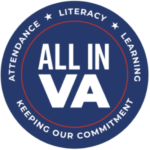The Governor announced today that he and the General Assembly came together on a bipartisan basis to invest $418 million to tackle student learning loss.
The Virginia Department of Education recommends school divisions allocate the $418 million “to proven programs that will achieve the greatest student impact—approximately 70% for high-dose tutoring, 20% for Virginia Literacy Act acceleration, and 10% for chronic absenteeism response.”
Press releases today from both from the Governor’s Office and the Virginia Department of Education provide both a lot of data and a plan to assess.
From VDOE’s “2022-2023 Test Results Show Virginia Students Continue to Struggle with COVID-Related Learning Loss in Reading and Math”
Today the Virginia Department of Education released the 2022-23 Virginia Assessment Results, demonstrating significant and persistent learning loss in reading and math for Virginia students in grades 3-8. More than half of 3rd-8th graders either failed or are at risk of failing their reading SOL exam, and nearly two-thirds of 3rd-8th graders either failed, or are at risk of failing, their math SOL exam….
In 2022-2023, the number of chronically absent students doubled from 2018-2019.
VDOE has also posted the school quality profiles to present the 2022-23 data. So you can look at your local school division or school.
From the Governor’s Office comes “Governor Glenn Youngkin Announces ALL IN VA Plan to Address COVID-19 Era Learning Loss and Absenteeism in Schools.” For the details, go here.
Attendance. There is to be a task force and at some point a playbook.
While there is lots of advice available, and it seems like good advice, the literature and studies on how to increase attendance have never been able to pin down with good science what works in either elementary or middle schools.
With this kind of pressure on attendance, human nature would suggest that the state and the divisions will need to address a way to validate the reporting of those figures.
The $41 million of new state money earmarked for attendance seems to indicate the hiring of truancy officers with the policies to back them up. Both are needed.
Literacy. The plan wants the money in part to fund the hiring and training of grade 4-8 reading specialists. Sounds exactly right.
After that the literacy portions of the plan await detail. That is understandable at this stage.
Learning. The learning plan components.
Invest in an intensive statewide tutoring initiative.
Students will receive 3 to 5 hours of tutoring per week. Students who are at risk (received a score of low proficient on their 2023 SOL) receive tutoring for 18 weeks, while students who are not proficient receive tutoring for up to 36 weeks.
Students will be tutored in groups with a 1:10 ratio led by current teachers, retired or part-time teachers, and/or trained tutors.
Tutoring can occur before or after school, during the school day, or during school breaks including summer depending on the needs in the school and the community.
Tutoring will entail personalized sessions that will be guided by digital tools used across all participating school divisions.
Digital content, tutor resources, and progress monitoring tools will be provided to local school divisions in both math and literacy.
That is a very aggressive plan. It is natural to wonder at this point where that many tutors will be found.
Perhaps one approach to fill some of the need is for the school divisions to hire the Multidivision Online Provider Program (MOP) companies. All of them are already approved to provide K-12 education in Virginia. All of their teachers are certified in Virginia.
Reston-based Stride Inc’s Virtual Virginia Academy is by far the largest provider nationally and in Virginia. The training is already personalized. Its Stride Skills Arcade seems already tailored to address Virginia’s needs and is very highly regarded.
I am sure Stride’s competitors in the MOP have similar programs.
Bottom line. There is a plan, or rather an outline of one, and money to start to execute it.
A sincere “well-done” to both the Governor’s team and the General Assembly.
Some initial observations and recommendations to the school divisions and principals:
- For attendance, don’t wait for a task force to re-invent the wheel. This advice seems excellent. It is also hard work. School divisions and principals can start with that.
- For the rest of the plan, it will take a great deal of good will, skill, innovation, effort and money for the school divisions to execute the plan.
- Use the MOPs. They will give you a head start on providing the required tutoring while you try to find enough qualified people to do it without them. I don’t think you will.
- Use the summers. You will need the extra time.
- $418 million is a start with state money. Use your own to supplement it.
Now we will watch supportively for the good will, innovation, skill and effort in each division, each school, and every parent and kid to take this and make progress with it.
Godspeed.


Leave a Reply
You must be logged in to post a comment.